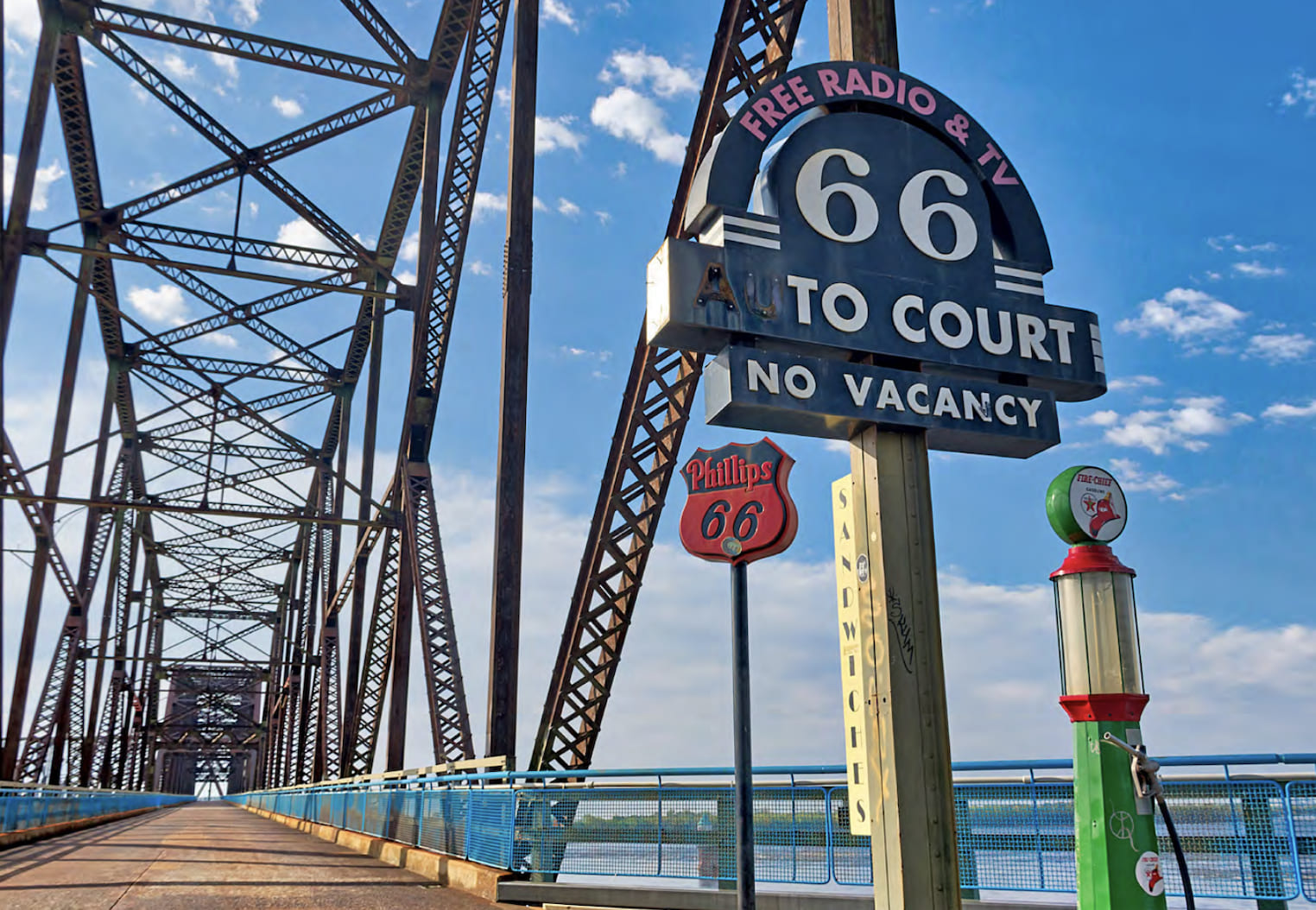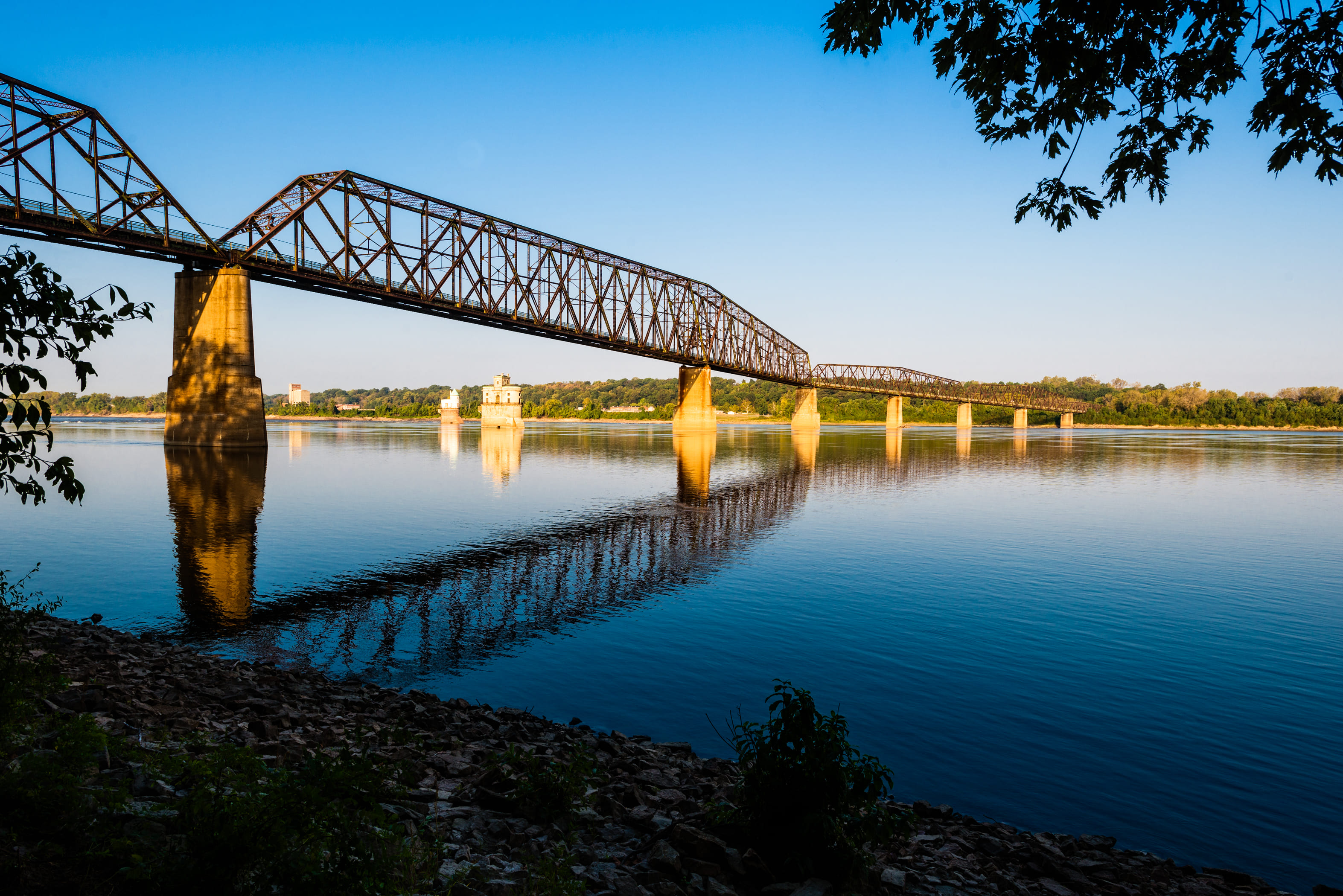With the Mississippi River being one of the largest dividing lines across the United States, naturally any national highway would have to cross it. In fact, throughout its life as an active highway, Route 66 crossed the boundary between Illinois and Missouri no fewer than four different times. The first crossing, in 1926, was via what is now known as the McKinley Bridge. Three years later, the Mother Road was rerouted over the Municipal Bridge, known today as the MacArthur Bridge. In 1936, it was rerouted again across the Chain of Rocks Bridge, and then it traveled across a pair of parallel bridges called the Veterans Memorial Bridge and Eads Bridge in 1954. Out of all of these crossings, it is the Chain of Rocks Bridge that has stood the test of time and implanted itself in the wonder of people all over the world.
This cantilever through-truss bridge was conceived in 1927 by Baxter L. Brown, an engineer from St. Louis, Missouri. Commissioned by a private association known as the Chain-of-Rocks and Kingshighway Bridge Company, the assignment was to build a highway over the mighty Mississippi near the rocky shoals — called the Chain of Rocks, which became the namesake for the Bridge — just north of St. Louis.
“They called [the shoals] the Chain of Rocks because the rocks there step down, [creating] waterfalls, and it was pretty amazing,” said Stephanie Tate, Marketing Communications Director at Great Rivers & Routes Tourism Bureau. “There were also some water intake towers placed in the river at about that point by the City of St. Louis, and that’s how they gathered their water for the city.”
These intake towers — built in 1894 with gothic, castle-like architecture, making them attractions in and of themselves — became a point of contention for the construction of the bridge. River boaters argued against the proximity of the bridge to the towers, where travel by water was already treacherous enough. The planned straightaway also was compounded by another problem: a section of the river’s bedrock wasn’t strong enough to support the bridge’s pylons — a product of glacial movement from the last ice age.

“So, they had to make a little jog,” explained Tate, “a little dogleg in the bridge to put it over on substantial bedrock. And that gives it its unique character — it’s not a straight bridge, it’s a bridge with a [30-degree bend] halfway across.”
This sudden shift in trajectory escalated the bridge’s budget from the expected $1,250,000 to just over $2.5 million, close to $30 million in today’s money. Nevertheless, construction was completed, and it was officially opened in July of 1929, after floods and ice on the river deterred the original opening date of January 1st, 1929. Stretching one mile long from Chouteau Island, Madison, Illinois, to St. Louis, Missouri, the bridge currently stands more than 60 feet above the Mississippi River — high enough to keep it clear of the most treacherous floods.
Chain-of-Rocks and Kingshighway Bridge Co. expected to make their money back through the toll booths set up on either side of the bridge, but initial traffic didn’t hit their numbers, and the bridge went bankrupt in 1931. The City of Madison bought the bridge for $2.3 million the following year — a move that preserved it long enough for the Mother Road to be directed across it in 1936. Thus, the bridge’s mark in history was established.
For the next 30 years, as the widest available river crossing, the Chain of Rocks Bridge did its job in shortening travel time between the states. On the Missouri side, the bridge was accented by the Chain of Rocks Park, a popular amusement park that attracted St. Louis patrons from 1927 to 1978. It would take until 1963, but eventually the Gateway Arch would join the view from the bridge downstream.
At only 24 feet in width, the tightness of the bridge, particularly at the bend, proved to be too dangerous for traffic over the years, influencing the decision to redirect Route 66 once more in 1954. The bridge became part of Bypass 66 instead, but it still tried to entice travelers by stopping the collection of tolls in August of 1957 — the booths were eventually removed altogether when the federal government forbade tolls for all U.S. highways in 1966. By that time, however, even Bypass 66 had moved — to Interstate 270, which went on to host a newly-built bridge just 2,000 feet upstream of the Chain of Rocks Bridge, in 1967. The new bridge was also christened the Chain of Rocks Bridge — with the signifier “New” in front — leaving the Old Chain of Rocks Bridge named exactly that.
With nothing left to distinguish it except for its awkward shape, the Old Bridge finally closed for good by the turn of the decade. As it rusted throughout the ‘70s, the Army considered demolishing the bridge, but the dropped value of scrap steel made the prospect more costly than profitable, so it was spared. It only had one minor job during this period, as a filming site for John Carpenter’s 1981 movie, Escape from New York, starring Kurt Russell and Adrienne Barbeau.
Fortunately, the bridge’s luck finally turned around in 1995, when a privately funded group called Trailnet, under the direction of the St. Louis mayor, formed a planning committee to restore the Old Bridge for the purpose of making it a part of the Route 66 Bikeway. From 1996 to 1999, Trailnet collected funds from Waste Management, Inc., Edward Jones, the Intermodal Surface Transportation Equity Act, and even a $2 million grant by Senator Christopher Bond. The operation was ready to roll.
“We contacted [an] engineering firm called Modjeski & Masters,” said Kevin Keach, the Project and Facilities Administrator at Trailnet. “And they identified some things we needed to, obviously, repair — the deck, which had a number of potholes in it — but we also had to do a lot of structural improvements [and] maintenance under it. We installed 10,000 linear feet of new railing so people couldn’t jump through the holes in the old railing. [The bridge] had a lot of lead in the paint, so we repainted and remediated the sections that people might be able to touch.”
On June 19, 1999, the Old Chain of Rocks Bridge reopened to the public, and by 2006 it was added to the National Register of Historic Places. No longer open to public traffic, the bridge is now free for pedestrians and bicyclists, for which the bend in the middle is not an obstacle, but instead a unique charm. Great Rivers Greenway, which leased the bridge in 2015, offers activities such as Eagle Day in January and an annual Route 66 Car Show. The Missouri side displays Route 66 memorabilia and interpretive signs, but safe parking has been a concern as the area isn’t monitored by security cameras like the Illinois side.
“We have been working for the past two years to design a new vision for the bridge on the Missouri side,” explained Anne Milford, Communications Coordinator of Great Rivers Greenway. “The focus of these improvements is to include public safety, security, sustainability — to create facilities for programs and events, and to the entry experience approaching the bridge. There’s landscaping [and] some other structures to be built, like security facilities. The construction will begin in late 2021 and will be completed in 2022.”
The Chain of Rocks Bridge has had a rocky history, but that history has resulted in its worldwide appeal today. From its massive, dog-legged span to its rise-and-fall story, mimicking the tide of the Mississippi, the bridge is proof that some things can’t be kept down, no matter how often they are battered or left in the dust. It is this impressive tenacity that ensures that the bridge will live on, offering expansive views of the wide Mississippi and inspiring road travelers for years to come.
